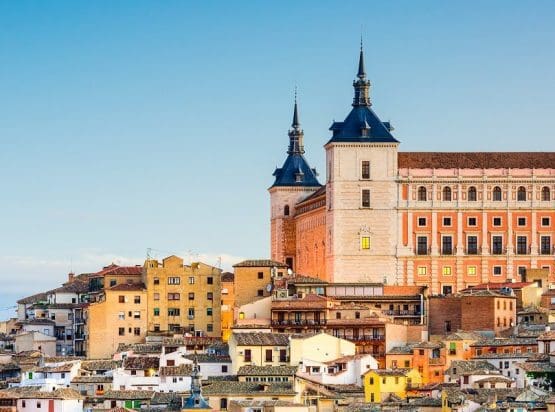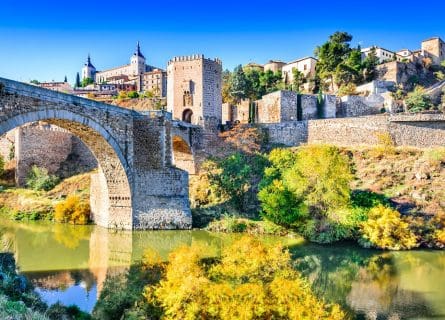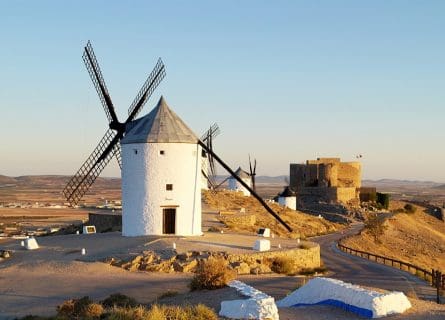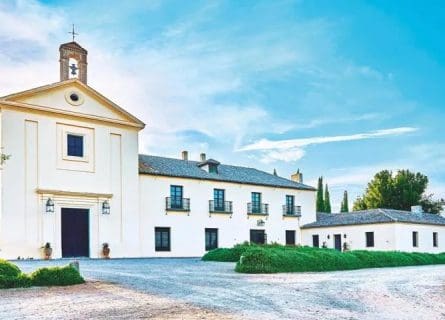Immerse yourself in Toledo's vibrant flavors and uncover hidden culinary gems with our expert insider guides. Plan an unforgettable trip today!
Read more
EXPLORE ALL OUR LA MANCHA WINE REGIONS GUIDE
Last updated: August 15, 2024
It is hard to believe that the arid, sunlit plains of Castilla-La Mancha could support a thriving wine industry. Yet La Mancha contains the world’s largest expanse of vines – more than all of Australia’s vineyards put together! Thanks to the extensive irrigation systems of the region, this high plateau south of Madrid produces incredible volumes of red and white wine. However, not all bodegas are interested in quality. Nevertheless, a growing firmament of winemakers in Méntrida have committed to the quality crusade, making single-site blends that excite critics and lure buyers. Thus far, the evidence suggests that Garnacha Tinta (Grenache) is the DO’s star grape. A growing rival to the best of Priorat and Rioja Oriental is on the cards.
Discover more about Spanish Wine

History comes alive in the meseta: La Mancha’s timeless beauty, windmills, and medieval castles were immortalized by Miguel de Cervantes in Don Quixote’s epic adventures. It also boasts one of Spain’s most beautiful cities, the former Visigothic capital of Toledo. However, many centuries before the Visigoths arrived in the Iberian Peninsula, Méntrida was a thriving Roman settlement in central Spain. Their hegemony endured until the Western Roman Empire fell apart in the 5th century, paving the way for chaos and constant power struggles between rival civilizations. The Visigoths made Toledo their capital in the 6th century – today, it is a very beautiful and popular museum city. In the Middle Ages, the city was a melting pot of Christian, Muslim, and Jewish cultures – one of the few examples of peaceful coexistence between the Moorish leaders who had arrived in 711 AD and the non-Muslim populace.
Yet the region became a battleground between Christians and Moors between the 9th-12th centuries, as the Reconquista successfully reconquered lost territories in northern and central Spain. Indeed, the name Castilla-La Mancha refers to the multitude of castles (castillos) built in the region. Some were used to defend reconquered territories from the Moors, while others mark the 14th- and 15th-century frontiers between the kingdoms of Aragon and Castile. These fierce rivals were united following the marriage of Isabel I of Castile and Fernando II of Aragon. The last Moorish stronghold, Granada, capitulated in 1492. Winegrowing also became important in Castilla-La Mancha during the Middle Ages, as religious orders from across Europe emigrated to the region. They assumed responsibility for Spain’s burgeoning wine industry, a state of affairs that endured for several centuries.
Colonization of the New World, meanwhile, generated vast wealth for Spain’s aristocracy. Unfortunately, the wider populace saw few benefits, as Spain’s despotic rulers squandered much of the gold on futile wars with rival European powers. To add insult to injury, Spain lost its colonies in the Philippines, and Central and South America, as independence fever swept through the New World. Public discontentment was rife by the time of the Spanish Civil War in 1936. After years of fierce fighting, the dictator Francisco Franco seized control from the Second Republic in 1939. Personal freedoms were severely curtailed during Franco as he ruled Spanish society with an iron fist; Spain’s wine industry became dominated by state-run cooperatives with little knack or interest in quality winemaking.
However, his death in the 1970s saw a transition to democracy and a market-orientated economy – Méntrida was awarded DO status in 1976. However, La Mancha set its stall on bulk winegrowing and cheap plonk in the 20th century; for some businesses, that will never change. Yet progress continues apace, with a steady conversion from the soulless Abillo whites to red varieties, such as Garnacha, that can thrive in this arid landscape. Méntrida has been at the forefront of this quality revolution as producers realize their future depends on selling premium labels to a discerning audience – at home and abroad.

They don’t call it el sartén (the frying pan) for nothing. In Castilla-La Mancha, picking can start in early August thanks to the fierce continental climate of the meseta. Indeed, there is nothing out of the ordinary (by local standards) when temperatures surpass 45°C in July and August; rainfall averages about 400mm per year. This “living hell,” to quote one winemaker, takes place in a northeastern corner of the Toledo province, southwest of Madrid. The scenery is evocative: mountain ranges, dramatic gorges, and expansive plains fill the sizable region of La Mancha. The vineyards of Méntrida lie to the southwest of the Sierra de Gredos mountains; undulating hills are punctuated by three rivers – the Alberche, Guadarrama, and Tagus – vitally important in the summer months. Nevertheless, viticulture without man-made irrigation would be simply impossible here.
Thankfully, the region’s sandy and granite terroir is ideally suited to the arid climate of Méntrida. These soils are very water-retentive, which helps vines to survive the torrid heat of July and August. But it is the altitude that makes all the difference here. Although some relatively low-lying vineyards are planted at 200 meters above sea level, favored sites rise to up to 800m. At these elevations, diurnal temperature variation (a significant difference in temperature between day and night) slows down the vine’s metabolism, maintaining freshness in the berries. As a result, the best ‘mountain wines’ of Méntrida combine acidity with ripeness. Their alcohol is seldom lower than 14.5%; however, it is usually balanced and not unwieldy.

Celebrated wine estate Dominio de Valdepusa set the benchmark for other producers to follow in Méntrida. Owned by the Carlos Falco family (founders of Rioja’s Marqués de Griñón), it cultivates an eclectic palate of varieties on its unique clay-limestone terroir, including Petit Verdot, Syrah, and Graciano. Bordeaux consultant Michel Rolland has also played a key role in Valdepusa’s development, advising the owners which varieties would best suit the soils and position in the zone. Produced in a state-of-the-art subterranean winery under the mansion, the wines are exceptional: fresh, nuanced, and deeply complex.
Of course, not every winemaker can aspire to the standards set at Valdepusa. Yet more and more bodegas are demonstrating that intense heat is no barrier to success in Méntrida, even if the growing conditions are very challenging. Nevertheless, producers can craft aromatic and balanced whites, often based on Sauvignon Blanc and Chardonnay, if the fruit is sourced from high-elevation sites. Careful juice handling and cool fermentation in stainless steel can yield remarkably fresh results if the berries arrive unspoiled. Thirty-five years ago, this style of wine was unheard-of in central Spain – modern technology and vastly improved viticultural management have made it all possible.
Still, the critics would argue that Méntrida’s greatest achievements are its voluptuous and perfumed reds. Blends and single-varietal styles are commonly encountered, based on a mixture of international and Spanish grapes. The Garnacha is particularly fine, thanks to the abundance of old bush vines that yield tiny berries of amazingly concentrated fruit. Bodegas Ziries leads the pack with its floral, perfumed, and impeccably balanced Navalegua label. But others are not far behind.
Méntrida has played an important role in revitalizing Garnacha’s reputation. It is one of the few grapes that can shine in this harsh climate, producing wines that offer a surprising amount of freshness considering the searing heat. For that reason, more and more winemakers are rediscovering this formerly maligned grape, particularly in light of global warming. In Castilla-La Mancha, late-ripening varieties that can tolerate periods of intense drought (Pinot Noir would simply wither and die under such conditions) are a hot commodity.
Ferran Centelles, former head sommelier at El Bulli restaurant in Catalunya, even regards Garnacha as one of Spain’s top viticultural assets, believing that “it acts as a powerful conduit between the terroir and the winery.” He says: “There is no other grape in Spain that transmits the characteristics of a particular site with such clarity and precision.” Of course, some critics would regard his proselytizing as overstating the case: many collectors are still unsure of the variety, regarding it with a mixture of apathy and suspicion. Yet there is no doubt that many exciting Spanish wines rely on gnarly old Grenache bush vines – centenarian plantings are one of Méntrida’s most precious natural resources. Sommeliers and key influencers continue their mission to bring more oenophiles on board.
However, Garnacha isn’t the only treasure to be found here. Michel Rolland hit the jackpot when he advised Carlos Falco to plant Petit Verdot at Dominio de Valdepusa. Another of the world’s unsung heroes, this late-ripener from Bordeaux is highly suited to the local terroir, yielding voluptuous and spicy wines that shine alongside Castilla-La Mancha’s robust cuisine. The best examples are concentrated, fresh, and fruit-driven, with plum, blackberry, violets, and garrigue aromas. Silky tannins and a welcome acidic ‘grip’ complete the picture. Yet, for now, Petit Verdot isn’t generating as much excitement as Garnacha in the vineyards south of Madrid, but it is only a matter of time. Another star beckons.
Exploring Albillo: Spain's Versatile Wine Grape in Ribera del Duero, Madrid, and Galicia. Uncover the Diversity of this Remarkable Varietal.
Find out moreChardonnay is a green-skinned grape varietal native to the Burgundy wine region in France and one of the most popular varieties worldwide.
Find out moreThe sauvignon blanc grape varietal, originally from the Bordeaux region of France, is now one of the world's most loved white varieties.
Find out moreDiscover Viura: Rioja's Prominent White Grape & Catalonia's Macabeo. Explore its versatility in exquisite wines. A must-read for wine enthusiasts.
Find out moreDiscover Tempranillo: Spain's iconic red grape. From Ribera del Duero to Toro, it yields concentrated wines. Explore its synonyms and unleash its prowess.
Find out moreDiscover the irresistible allure of Cabernet Sauvignon—a worldwide favorite with robust, dark-bodied flavor. Unleash your wine journey today!
Find out moreGarnacha: Spain's Red Gem. Akin to Pinot Noir, it bridges terroir and winemaking, crafting captivating expressions.
Find out moreMerlot is the most cultivated grape in Bordeaux and closely related to Cabernet Franc
Find out morePetit Verdot is a full-bodied red wine grape varietal used in classic Bordeaux blends and originates in southwestern France
Find out moreThe cuisine of Castilla-La Mancha is seldom art-on-a-plate; locals generally have no interest in molecular gastronomy and bijou portion sizes. However, it is always delicious and seasonal, particularly in the vibrant tapas bars of Méntrida and nearby Toledo. But chefs in La Mancha have always preferred to maintain a tradition of homely, robust cooking with a variety of warming one-pot stews. The Cabrito al ajillo (kid fried with onions and herbs) must be tried, in addition to the famous Manchego cheese and pisto: Spain’s version of ratatouille.

Immerse yourself in Toledo's vibrant flavors and uncover hidden culinary gems with our expert insider guides. Plan an unforgettable trip today!
Read more
Immerse yourself in Madrid's vibrant flavors and uncover hidden culinary gems with our expert insider guides. Plan an unforgettable trip today!
Read moreIf you would like us to customize an exclusive luxury tour, contact us and let us know your travel plans. We offer luxury food and wine tours for private groups of a mininium two guests. In addition, all of our private, chauffeured tours are available year-round upon request.

